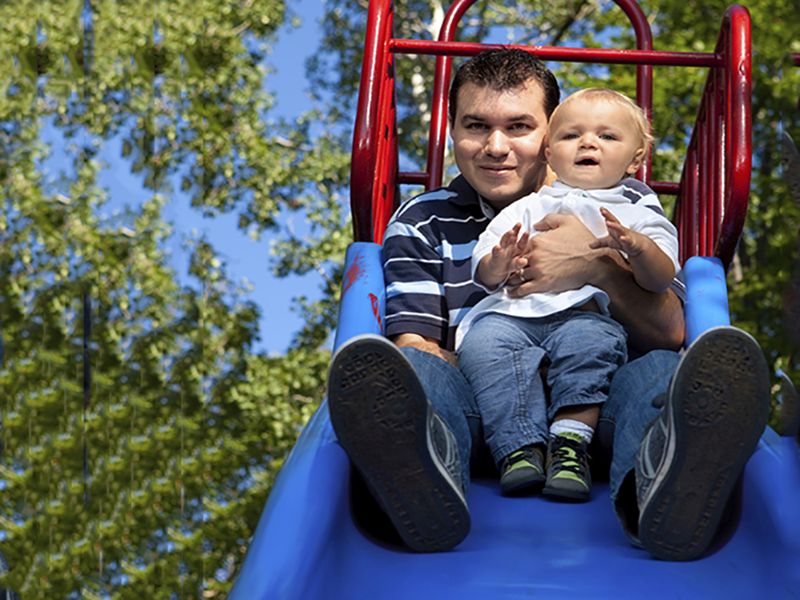Green Space Good for Your Child's Mental Health
By Dennis ThompsonHealthDay Reporter

MONDAY, Feb. 25, 2019 (HealthDay News) -- Living near a park, forest or other green space may protect your children's mental health later in life, a new Danish study suggests.
Children who grow up in these natural surroundings have up to a 55 percent lower risk of developing a mental disorder as an adult, researchers found.
Further, the protective effect grows stronger with more years spent living near nature, said lead researcher Kristine Engemann, a postdoctoral researcher at Aarhus University in Denmark.
"We found that association was stronger when we calculated a cumulative measure of green space from birth to age 10 compared to measuring green space at one single year," Engemann said. "This indicates that the positive association builds up over time, and that being exposed to green space throughout childhood is important."
For the study, Engemann and her colleagues gathered registry data on all Danish citizens, as well as data on all residents registered as suffering from a psychiatric disorder.
The investigators then used satellite data to assess the amount of green space near each person in the registry, from birth up to age 10.
Though the study could only show an association, the researchers found that high levels of green space present in childhood was linked to a lower risk of a wide spectrum of mental problems in adulthood, even after adjusting for other risk factors like financial and social status, the stress of urban living, and any family history of psychiatric disorders.
The psychiatric disorders most strongly associated with living near parks or forests were substance abuse disorders (52 percent decreased risk) -- including cannabis (44 percent) and alcohol abuse (55 percent) -- and neurotic or stress-related disorders (40 percent), Engemann said.
Her team also found that green space appeared to lower the risk of personality disorders, bipolar and mood disorders, and schizophrenia.
These results show that the urban environment is "an important environmental risk factor for mental health," Engemann said.
"Ensuring access to green space and enhancing opportunities for a diverse range of uses, especially in densifying urban environments, could be an important tool for managing and minimizing the global burden of disease increasingly dominated by psychiatric disorders," Engemann said.
The natural world appears to benefit both the body and the mind in growing children, Engemann said.
People raised in an urban setting "have been found to have higher neural activity linked to stress processing, which could lead to higher risk of psychiatric disorders in adults," she noted.
"Green space is also known to enhance psychological restoration, affect brain structure through positive associations with amygdala integrity, and could mitigate negative effects from the socially dense and noisy city environment that heighten stress," Engemann said. The amygdala is a region of the brain focused on emotions.
Neighborhood greenery can also decrease air pollution, bring neighbors closer together, and encourage people to be more physically active, she added.
The findings were published Feb. 25 in the Proceedings of the National Academy of Sciences.
Kids regularly exposed to green space benefit from a wide array of sensual stimulation, touching and smelling and observing all the plants and animals and features there, explained Alice Honig. She's a professor emerita of child development at Syracuse University in New York.
They also have a chance to burn off excess energy by running and playing, Honig added.
Children can benefit from these environments even if they live in a big city, said Honig, author of the book, "Experiencing Nature With Young Children."
"Suppose you're an urban parent who can't afford a car. Find out where the closest parks and swimming pools and botanical gardens in your community are on a bus line or train line," Honig recommended. "Even if you live in New York City, there are some pretty wild parks in the Bronx. I learned to ride a bike in one of those years ago."
Schools should also be able to help parents find green spaces near them, Honig added.
Policymakers and local officials ought to keep these findings in mind when setting aside space for parks and other public features, Engemann said.
"For city planners, our results suggest that green space might contribute large health benefits across the population, and maintaining or even increasing green space in residential areas could potentially lead to significant health benefits," she said.
More information
Project Evergreen has more about the benefits of green space.

The news stories provided in Health News and our Health-E News Newsletter are a service of the nationally syndicated HealthDay® news and information company. Stories refer to national trends and breaking health news, and are not necessarily indicative of or always supported by our facility and providers. This information is provided for informational and educational purposes only, and is not intended to be a substitute for medical advice, diagnosis, or treatment.

